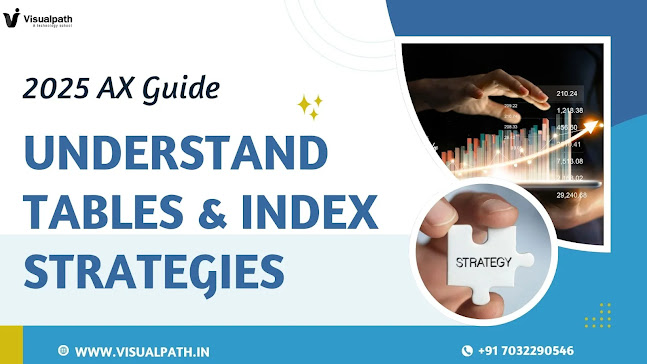- Get link
- X
- Other Apps
- Get link
- X
- Other Apps
2025 AX Guide to Table Structure
Microsoft
Dynamics AX training in ameerpet remains a vital ERP system in 2025. Its table
structure is crucial for data integrity. Tables store all transactional,
master, and reference data. Each table has a unique purpose and design. The 2025
AX Guide covers the core architecture.
Tables in AX 2025 follow normalized models.
This enhances data storage and reduces duplication. Relations between tables
are enforced through foreign keys. Each table is defined in the AOT
(Application Object Tree). Developers must understand these layers in detail.
Table hierarchies remain a top design
priority. Base tables handle common fields. Derived tables hold module-specific
data. This supports modular development and customization. AX 2025 continues to
adopt this layered table structure.
Changes in 2025 emphasize better entity
mapping. Microsoft has improved how tables relate in Power Platform. Data
integration between AX and Dataverse has become seamless. This boosts analytics
and reporting features.
2025 AX Guide on Index Concepts
Indexes are the backbone of query performance.
Without proper indexes, AX queries slow down. The 2025 AX Guide explores smart
index strategies in 2025. Microsoft has introduced dynamic indexing in recent
updates.
Indexes now adapt to query patterns
automatically. This reduces the need for manual tuning. Microsoft
Ax training tables now support memory-optimized indexes. These indexes work
well with high transaction volumes. Especially in finance and logistics
modules.
Each index in AX must follow best practices.
Avoid wide indexes with many columns. Always place frequently filtered columns
first. Clustered indexes remain default on primary keys. Non-clustered indexes
should support secondary lookups.
With the April 2025 release, Microsoft
Ax training added index diagnostics. Developers can track index usage in
real-time. This helps in removing unused indexes. It also highlights missing
indexes that can improve performance.
2025 AX Guide for Index Maintenance
Index maintenance is a continuous process. It
ensures consistent query speed. The 2025 AX Guide suggests regular index
rebuilds. Fragmentation remains a common issue. AX 2025 tools now allow
automated index optimization.
Index statistics are refreshed using
background jobs. This improves query plans in SQL Server. The Lifecycle
Services (LCS) portal now includes index reports. These reports offer insights
into large table access patterns.
Microsoft recommends rebuilding indexes
weekly. Especially for tables with more than 10,000 rows. Developers can also
enable automatic index tuning in Azure
SQL. This feature auto-creates or drops indexes based on telemetry.
Changes in 2025 also added alerts for high
table scans. When a table lacks an index, an alert appears. This helps
administrators act fast to improve performance.
2025 AX Guide on Table Types
Not all tables in AX are alike. The 2025 AX
Guide breaks them into types. Foundation tables hold master data like Customers
or Items. Transactional tables record day-to-day activity. Journal tables log
changes and approvals.
AX 2025 improves table categorization in AOT.
A new field "Table Usage" was added in February 2025. It helps
developers assign correct types. This supports better cache settings and load
time.
Microsoft
Dynamics AX training in ameerpet In-memory tables have become more popular.
These are used in batch jobs and temporary storage. AX 2025 also supports blob
storage tables. Useful in attachments and document management.
Table permissions are another focus area.
Security roles now control table access with more granularity. The March 2025
security patch improved data access compliance. Especially for healthcare and
finance industries.
2025 AX Guide for Performance Tuning
Performance tuning is critical in AX
environments. The 2025 AX Guide recommends reviewing query plans often. Tools
like SQL Server Management Studio (SSMS) remain essential.
AX 2025 supports more telemetry integration.
You can now track slow queries using Azure Monitor. This data can be used to
refine indexes. It also shows which tables have the most reads or writes.
Developers can use the Query Analyzer tool in
Visual Studio. It simulates how indexes affect performance. This was updated in
the January 2025 platform release.
Another trend in 2025 is columnstore
indexing. Large fact tables in reporting benefit from this. AX users should
apply columnstore indexes on analytic tables. This helps with Power BI and
warehouse loads.
AX 2025 also promotes data archiving. Stale
records in transactional tables slow down indexes. Archiving improves index
performance. Microsoft released an archiving tool in April 2025 for this
purpose.
Conclusion
The 2025 AX Guide helps teams manage tables
and indexes efficiently. With frequent updates from Microsoft, AX 2025 is more
optimized than ever. Tables are smarter, and indexes work better with built-in
intelligence.
To keep AX systems running smoothly, follow
the strategies in this guide. From table structure to index tuning, every step
matters. With the right approach, Dynamics AX 2025 becomes faster and more
reliable.
For long-term ERP success, mastering
tables and indexes is a must. Stay updated with Microsoft releases. Use
built-in tools and follow performance best practices. The 2025 AX Guide is your
go-to resource for mastering these essentials.
Trending
Courses: Snowflake
Course, Sailpoint
Identity IQ, Dynamics
365 Supply Chain Management
Visualpath is the Leading and Best
Institute for learning in Hyderabad. We provide MicroSoft
Dynamics Ax Training in India. You will get the best course at an
affordable cost.
For
more Details Contact +91 7032290546
Visit:
https://www.visualpath.in/online-microsoft-dynamics-ax-technical-training.html
MicroSoft Ax Training
Microsoft Dynamics 365
Microsoft Dynamics 365 Training Courses
Microsoft Dynamics AX Technical Training
Microsoft Dynamics AX Training
MicroSoft Dynamics Ax Training Online
- Get link
- X
- Other Apps

Comments
Post a Comment